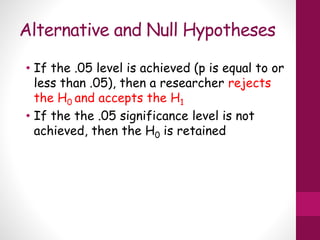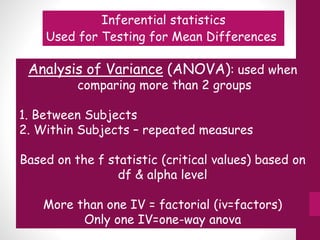Inferential Statistics
- 2. Descriptive & Inferential Statistics Descriptive Statistics Organize • Summarize • Simplify • Presentation of data Inferential Statistics • Generalize from samples to pops • Hypothesis testing • Relationships among variables Describing data Make predictions
- 3. Inferential Statistics • Inferential statistics are used to draw conclusions about a population by examining the sample POPULATION Sample
- 4. Inferential Statistics Population Sample Draw inferences about the larger group Sample Sample Sample
- 5. data Are our inferences valid?…Best we can do is to calculate probability about inferences
- 6. Inferential Statistics • Accuracy of inference depends on representativeness of sample from population • random selection • equal chance for anyone to be selected makes sample more representative
- 7. Inferential Statistics • Inferential statistics help researchers test hypotheses and answer research questions, and derive meaning from the results
- 8. Sampling Error: variability among samples due to chance vs population Or true differences? Are just due to sampling error? Probability….. Error…misleading…not a mistake
- 9. Inferential Statistics • Researchers set the significance level for each statistical test they conduct
- 10. Alternative and Null Hypotheses • If the .05 level is achieved (p is equal to or less than .05), then a researcher rejects the H0 and accepts the H1 • If the the .05 significance level is not achieved, then the H0 is retained
- 11. Degrees of Freedom • Degrees of freedom (df) are the way in which the scientific tradition accounts for variation due to error • it specifies how many values vary within a statistical test • scientists recognize that collecting data can never be error-free • each piece of data collected can vary, or carry error that we cannot account for • by including df in statistical computations, scientists help account for this error
- 12. Inferential Statistics: 5 Steps • To determine if SAMPLE means come from same population, use 5 steps with inferential statistics 1. State Hypothesis • Ho: no difference between 2 means; any difference found is due to sampling error • any significant difference found is not a TRUE difference, but CHANCE due to sampling error • results stated in terms of probability that Ho is false • findings are stronger if can reject Ho • therefore, need to specify Ho and H1
- 13. Steps in Inferential Statistics 2. Level of Significance • Probability that sample means are different enough to reject Ho (.05 or .01) • level of probability or level of confidence
- 14. Steps in Inferential Statistics 3. Computing Calculated Value • Use statistical test to derive some calculated value (e.g., t value or F value) 4. Obtain Critical Value • a criterion used based on df and alpha level (.05 or .01) is compared to the calculated value to determine if findings are significant and therefore reject Ho
- 15. Steps in Inferential Statistics 5. Reject or Fail to Reject Ho • CALCULATED value is compared to the CRITICAL value to determine if the difference is significant enough to reject Ho at the predetermined level of significance • If CRITICAL value > CALCULATED value --> fail to reject Ho • If CRITICAL value < CALCULATED value --> reject Ho • If reject Ho, only supports H1; it does not prove H1
- 16. Testing Hypothesis • If reject Ho and conclude groups are really different, it doesn’t mean they’re different for the reason you hypothesized • may be other reason • Since Ho testing is based on sample means, not population means, there is a possibility of making an error or wrong decision in rejecting or failing to reject Ho • Type I error • Type II error
- 17. Testing Hypothesis • Type I error -- rejecting Ho when it was true (it should have been accepted) • equal to alpha • if = .05, then there’s a 5% chance of Type I error • Type II error -- accepting Ho when it should have been rejected • If increase , you will decrease the chance of Type II error
- 18. Inferential Statistics: uses sample data to evaluate the credibility of a hypothesis about a population NULL Hypothesis: NULL (nullus - latin): “not any” no differences between means H0 : m1 = m2 “H- Naught”Always testing the null hypothesis
- 19. Inferential statistics: uses sample data to evaluate the credibility of a hypothesis about a population Hypothesis: Scientific or alternative hypothesis Predicts that there are differences between the groups H1 : m1 = m2
- 20. Hypothesis A statement about what findings are expected null hypothesis "the two groups will not differ“ alternative hypothesis "group A will do better than group B" "group A and B will not perform the same"
- 21. Inferential Statistics When making comparisons btw 2 sample means there are 2 possibilities Null hypothesis is true Null hypothesis is false Not reject the Null Hypothesis Reject the Null hypothesis
- 22. Possible Outcomes in Hypothesis Testing (Decision) Null is True Null is False Accept Reject Correct Decision Correct Decision Error Error Type I Error Type II Error Type I Error: Rejecting a True Hypothesis Type II Error: Accepting a False Hypothesis
- 23. Hypothesis Testing - Decision Decision Right or Wrong? But we can know the probability of being right or wrong Can specify and control the probability of making TYPE I of TYPE II Error Try to keep it small…
- 24. ALPHA the probability of making a type I error depends on the criterion you use to accept or reject the null hypothesis = significance level (smaller you make alpha, the less likely you are to commit error) 0.05 (5 chances in 100 that the difference observed was really due to sampling error – 5% of the time a type I error will occur) Possible Outcomes in Hypothesis Testing Null is True Null is False Accept Reject Correct Decision Correct Decision Error Error Type I Error Type II Error Alpha () Difference observed is really just sampling error The prob. of type one error
- 25. When we do statistical analysis… if alpha (p value- significance level) greater than 0.05 WE ACCEPT THE NULL HYPOTHESIS is equal to or less that 0.05 we REJECT THE NULL (difference btw means)
- 26. 2.5% 2.5% 5% region of rejection of null hypothesis Non directional Two Tail
- 27. 5% 5% region of rejection of null hypothesis Directional One Tail
- 28. BETA Probability of making type II error occurs when we fail to reject the Null when we should have Possible Outcomes in Hypothesis Testing Null is True Null is False Accept Reject Correct Decision Correct Decision Error Error Type I Error Type II Error Beta (b) Difference observed is real Failed to reject the Null POWER: ability to reduce type II error
- 29. POWER: ability to reduce type II error (1-Beta) – Power Analysis The power to find an effect if an effect is present 1. Increase our n 2. Decrease variability 3. More precise measurements Effect Size: measure of the size of the difference between means attributed to the treatment
- 30. Inferential statistics Significance testing: Practical vs statistical significance
- 31. Inferential statistics Used for Testing for Mean Differences T-test: when experiments include only 2 groups a. Independent b. Correlated i. Within-subjects ii. Matched Based on the t statistic (critical values) based on df & alpha level
- 32. Inferential statistics Used for Testing for Mean Differences Analysis of Variance (ANOVA): used when comparing more than 2 groups 1. Between Subjects 2. Within Subjects – repeated measures Based on the f statistic (critical values) based on df & alpha level More than one IV = factorial (iv=factors) Only one IV=one-way anova
- 33. Inferential statistics Meta-Analysis: Allows for statistical averaging of results From independent studies of the same phenomenon
- 34. Identifying the Appropriate Statistical Test of Difference One variable One-way chi-square Two variables (1 IV with 2 levels; 1 DV) t-test Two variables (1 IV with 2+ levels; 1 DV) ANOVA Three or more variables ANOVA


































